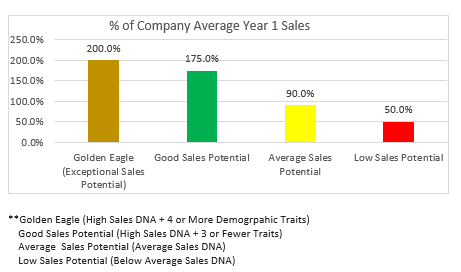Welcome to the last of our recent blog series on the predictive characteristics of successful competitive sales hires. For those of you who may have just found this blog series, the seven previous topics were: (1) Coming from a Warm Referral Source; (2) Being Employed at the Time of Applying; (3) Possessing at least 3 Years of Competitive Sales Experience; (4) Previous Job Stability; (5) Working > 45 Hours per Week; (6) Believe in What You Are Selling and (7) The Ideal Recruit for Competitive Sales Positions.
Unlike previous installments which have focused on a series of individual demographic screening characteristics, this blog is intended to highlight the additive impact that these attributes offer to an already predictive validated psychometric assessment tool like the Predictor of Potential (POP™).
Research has been unequivocal in demonstrating that psychometric attributes (stable personality traits) are far more predictive of higher and sustained performance and retention than are demographic attributes (unstable / descriptive). The foundation of any best practices recruitment & selection process must be a validated psychometric assessment. Nevertheless, there are numerous benefits and complementary utilities that adding demographic traits can provide, which were ultimately the impetus behind the development of Self Management Group’s POP™ assessment tool. The POP™ is believed to be the only assessment in the market place that harnesses the predictive and synergistic powers of both psychographic and demographic data points. Below are the predictive impacts associated with the POP™ scoring methodology:

These tables clearly illustrate the predictive power of the POP™’s measure of sales DNA using a traffic light (Green vs Amber vs Red), and the additional bonus lift that the ideal recruit profile (e.g., demographics) can provide. This complimentary and robust assessment methodology provides unparalleled predictive power when evaluating competitive sales candidates.
Using our sample company comprised of 100 sales reps, most organizations have 40% of their hires in the Yellow or Red range.
Average 1st Year Production: $200,000
Average Cost of Hiring / Training / Onboarding: $20,000
If company A was to re-select the 40% of hires with these below average ratings as Golden Eagle hires, the organizational impact would be:
40 reps x $260,000 in additional Year 1 production = $10,400,000
18 additional reps retained @ $20,000 in savings = $360, 0000
For a grand total ROI of $10,760,000
The addition of these ideal demographic characteristics to an already robust psychometric assessment like the POP™ offers other advantages as well. First, it provides a very specific “recruitment profile”, allowing recruiters to focus their attention on recruitment channels / candidates with the highest Return on Investment and Energy. Second, it helps focus recruiters on predictive data points, and thus takes the subjectivity out of much of the screening and manual resume parsing that currently takes place. In fact, with the advent of new AI technology, these predictive attributes can be prioritized and weighted in the screening process, allowing the AI technology to return the highest of quality results.
The reason that psychographic data points (like the ones measured through the POP™) are more predictive of future performance and retention is because of their dispositional, and stable nature. They are scientific data
points that do not change overtime, and thus one is able to make very accurate predictive judgements on future events like performance and retention. They are also more robust constructs that more closely align with the competencies that are essential for the day-to-day success of competitive sales people (e.g., prospecting, closing, handling rejection). It is for these reasons that all “best practices” recruitment processes included a validated psychometric assessment at their core, and that something like demographic attributes are simply used in an additive manner.
The POP™ also has a number of critical secondary and tertiary utilities that cannot be replicated using simple demographic factors. For example, the POP™ report provides information that can be used to support a new hires on-boarding, training & development, and more importantly, provides insight to the new hire’s manager on how to most effectively coach and work with them. The POP™ can also be used for Team Building, cross-recruiting and career management. Finally, the POP™ is benchmarked and calibrated to provide a preview into the new hire’s capacity for future management or leadership success. This feature is essential to supporting an organization’s talent pipeline, ensuring that selection decisions are not only being made to fill front line roles, but are also ensuring depth in their succession planning pipeline.
In summary, psychographic characteristics are far more predictive than demographic attributes, and thus must be at the heart of any proper recruitment / selection process. In many cases demographic-based tools are marketed as predictive selection assessments, when they are simply screening products. One must be very careful to make this distinction when considering selection testing. If the test only takes a few minutes to complete, and is relatively inexpensive, you are getting what you are paying for from a predictive perspective. Assessments like the POP™, which emphasize psychographic factors and use customized and validated demographic factors to supplement the predictive algorithm, are the future of selection assessments. These tools are not only the most robust and predictive, but they also support many other important talent functions as well (e.g., development, training, coaching, succession planning, career management, career pathing etc…).
Self Management Group has a 42 year track record of helping some of the world’s largest companies attract, select and retain top talent. If you are interested in learning more about the POP™ or our Talent Analytics Advisory Service (TaaS), please visit our website to request a demonstration.
